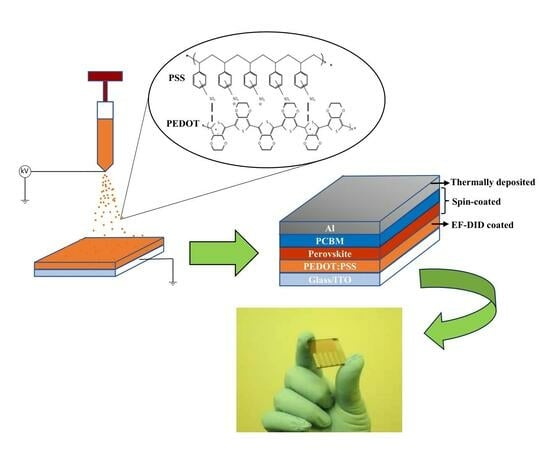Ultrafast and Large-Scale Fabrication of PEDOT:PSS Nanofilms Using Electrical-Field-Assisted Direct Ink Deposition
Abstract
1. Introduction
2. Results and Discussion
2.1. Film Morphology
2.2. Film Wettability
2.3. EF-DID-Sprayed vs. Spin-Coated Nanofilms
3. Materials and Methods
3.1. Electrical-Field-Assisted Direct Ink Deposition of PEDOT:PSS
3.2. Ink Preparation
3.3. Thin Film Fabrication
3.4. Characterization
4. Conclusions
Author Contributions
Funding
Institutional Review Board Statement
Informed Consent Statement
Data Availability Statement
Conflicts of Interest
Sample Availability
References
- Groenendaal, L.; Jonas, F.; Freitag, D.; Pielartzik, H.; Reynolds, J.R. Poly(3,4-Ethylenedioxythiophene) and Its Derivatives: Past, Present, and Future. Adv. Mater. 2000, 12, 481–494. [Google Scholar] [CrossRef]
- Yue, R.; Xu, J. Poly(3,4-Ethylenedioxythiophene) as Promising Organic Thermoelectric Materials: A Mini-Review. Synth. Met. 2012, 162, 912–917. [Google Scholar] [CrossRef]
- Elschner, A.; Kirchmeyer, S.; Lovenich, W.; Merker, U.; Reuter, K. PEDOT: Principles and Applications of an Intrinsically Conductive Polymer; CRC Press: Boca Raton, FL, USA, 2010; ISBN 978-0-429-13738-9. [Google Scholar]
- Perepichka, I.F.; Perepichka, D.F. Handbook of Thiophene-Based Materials: Applications in Organic Electronics and Photonics; Wiley: Chichester, UK, 2009; ISBN 978-0-470-05732-2. [Google Scholar]
- Zhang, B.; Sun, J.; Katz, H.E.; Fang, F.; Opila, R.L. Promising Thermoelectric Properties of Commercial PEDOT:PSS Materials and Their Bi 2 Te 3 Powder Composites. ACS Appl. Mater. Interfaces 2010, 2, 3170–3178. [Google Scholar] [CrossRef]
- Yano, H.; Kudo, K.; Marumo, K.; Okuzaki, H. Fully Soluble Self-Doped Poly(3,4-Ethylenedioxythiophene) with an Electrical Conductivity Greater than 1000 S cm−1. Sci. Adv. 2019, 5, eaav9492. [Google Scholar] [CrossRef]
- Ouyang, J. “Secondary Doping” Methods to Significantly Enhance the Conductivity of PEDOT:PSS for Its Application as Transparent Electrode of Optoelectronic Devices. Displays 2013, 34, 423–436. [Google Scholar] [CrossRef]
- Patra, A.; Bendikov, M.; Chand, S. Poly(3,4-Ethylenedioxyselenophene) and Its Derivatives: Novel Organic Electronic Materials. Acc. Chem. Res. 2014, 47, 1465–1474. [Google Scholar] [CrossRef] [PubMed]
- Greczynski, G.; Kugler, T.; Salaneck, W.R. Characterization of the PEDOT-PSS System by Means of X-Ray and Ultraviolet Photoelectron Spectroscopy. Thin Solid Films 1999, 354, 129–135. [Google Scholar] [CrossRef]
- Yildiz, S.; Cai, J.L.; Fan, Q.G. Effects of Solvents on the Electrical Resistance of Poly(3,4-Ethylenedioxythiophene) on Textiles. Adv. Mater. Res. 2012, 441, 16–22. [Google Scholar] [CrossRef]
- Kim, Y.H.; Sachse, C.; Machala, M.L.; May, C.; Müller-Meskamp, L.; Leo, K. Highly Conductive PEDOT:PSS Electrode with Optimized Solvent and Thermal Post-Treatment for ITO-Free Organic Solar Cells. Adv. Funct. Mater. 2011, 21, 1076–1081. [Google Scholar] [CrossRef]
- Kirchmeyer, S.; Reuter, K. Scientific Importance, Properties and Growing Applications of Poly(3,4-Ethylenedioxythiophene). J. Mater. Chem. 2005, 15, 2077. [Google Scholar] [CrossRef]
- Kemerink, M.; Timpanaro, S.; De Kok, M.M.; Meulenkamp, E.A.; Touwslager, F.J. Three-Dimensional Inhomogeneities in PEDOT:PSS Films. J. Phys. Chem. B 2004, 108, 18820–18825. [Google Scholar] [CrossRef]
- Xia, Y.; Ouyang, J. PEDOT:PSS Films with Significantly Enhanced Conductivities Induced by Preferential Solvation with Cosolvents and Their Application in Polymer Photovoltaic Cells. J. Mater. Chem. 2011, 21, 4927. [Google Scholar] [CrossRef]
- Eslamian, M.; Newton, J. Spray-on PEDOT:PSS and P3HT:PCBM Thin Films for Polymer Solar Cells. Coatings 2014, 4, 85–97. [Google Scholar] [CrossRef]
- Krebs, F.C. Fabrication and Processing of Polymer Solar Cells: A Review of Printing and Coating Techniques. Sol. Energy Mater. Sol. Cells 2009, 93, 394–412. [Google Scholar] [CrossRef]
- Cho, C.-K.; Hwang, W.-J.; Eun, K.; Choa, S.-H.; Na, S.-I.; Kim, H.-K. Mechanical Flexibility of Transparent PEDOT:PSS Electrodes Prepared by Gravure Printing for Flexible Organic Solar Cells. Sol. Energy Mater. Sol. Cells 2011, 95, 3269–3275. [Google Scholar] [CrossRef]
- Yu, X.; Smith, J.; Zhou, N.; Zeng, L.; Guo, P.; Xia, Y.; Alvarez, A.; Aghion, S.; Lin, H.; Yu, J.; et al. Spray-combustion synthesis: Efficient solution route to high-performance oxide transistors. Proc. Natl. Acad. Sci. USA 2015, 112, 3217–3222. [Google Scholar] [CrossRef]
- Dastgeer, G.; Afzal, A.M.; Nazir, G.; Sarwar, N. p-GeSe/n-ReS2 Heterojunction Rectifier Exhibiting a Fast Photoresponse with Ultra-High Frequency-Switching Applications. Adv. Mater. Interfaces 2021, 8, 2196–7350. [Google Scholar] [CrossRef]
- Dastgeer, G.; Nisar, S.; Shahzad, Z.F.; Rasheed, A.; Kim, D.; Jaffery, S.H.A.; Wang, L.; Usman, M.; Eom, J. Low-Power Negative-Differential-Resistance Device for Sensing the Selective Protein via Supporter Molecule Engineering. Adv. Sci. 2023, 10, 2198–3844. [Google Scholar] [CrossRef]
- Zhu, Y.; Gogoi, B.; Alluri, P.; Suhas Despande, M.; Hutchins, J.; Tagbor, E.; Alford, T.L.; Li, X. 3D Printing of Largescale Functional Nanofilm Using Electrically Assisted Direct Ink Deposition. Manuf. Lett. 2022, 33, 744–751. [Google Scholar] [CrossRef]
- Zhou, H.; Chen, Q.; Li, G.; Luo, S.; Song, T.; Duan, H.-S.; Hong, Z.; You, J.; Liu, Y.; Yang, Y. Interface Engineering of Highly Efficient Perovskite Solar Cells. Science 2014, 345, 542–546. [Google Scholar] [CrossRef]
- Lee, S.H.; Sohn, J.S.; Kulkarni, S.B.; Patil, U.M.; Jun, S.C.; Kim, J.H. Modified Physico–Chemical Properties and Supercapacitive Performance via DMSO Inducement to PEDOT:PSS Active Layer. Org. Electron. 2014, 15, 3423–3430. [Google Scholar] [CrossRef]
- Zabihi, F.; Xie, Y.; Gao, S.; Eslamian, M. Morphology, Conductivity, and Wetting Characteristics of PEDOT:PSS Thin Films Deposited by Spin and Spray Coating. Appl. Surf. Sci. 2015, 338, 163–177. [Google Scholar] [CrossRef]
- Ramizy, A.; Hassan, Z.; Omar, K.; Al-Douri, Y.; Mahdi, M.A. New Optical Features to Enhance Solar Cell Performance Based on Porous Silicon Surfaces. Appl. Surf. Sci. 2011, 257, 6112–6117. [Google Scholar] [CrossRef]
- Cameron, J.; Skabara, P.J. The Damaging Effects of the Acidity in PEDOT:PSS on Semiconductor Device Performance and Solutions Based on Non-Acidic Alternatives. Mater. Horiz. 2020, 7, 1759–1772. [Google Scholar] [CrossRef]
- Reza, K.M.; Mabrouk, S.; Qiao, Q. A Review on Tailoring PEDOT:PSS Layer for Improved Performance of Perovskite Solar Cells. Proc. Nat. Res. Soc. 2018, 2, 02004. [Google Scholar] [CrossRef]
- Loeb, L.B.; Kip, A.F.; Hudson, G.G.; Bennett, W.H. Pulses in Negative Point-to-Plane Corona. Phys. Rev. 1941, 60, 714–722. [Google Scholar] [CrossRef]
- Kim, J.Y.; Jung, J.H.; Lee, D.E.; Joo, J. Enhancement of Electrical Conductivity of Poly(3,4-Ethylenedioxythiophene)/Poly(4-Styrenesulfonate) by a Change of Solvents. Synth. Met. 2002, 126, 311–316. [Google Scholar] [CrossRef]
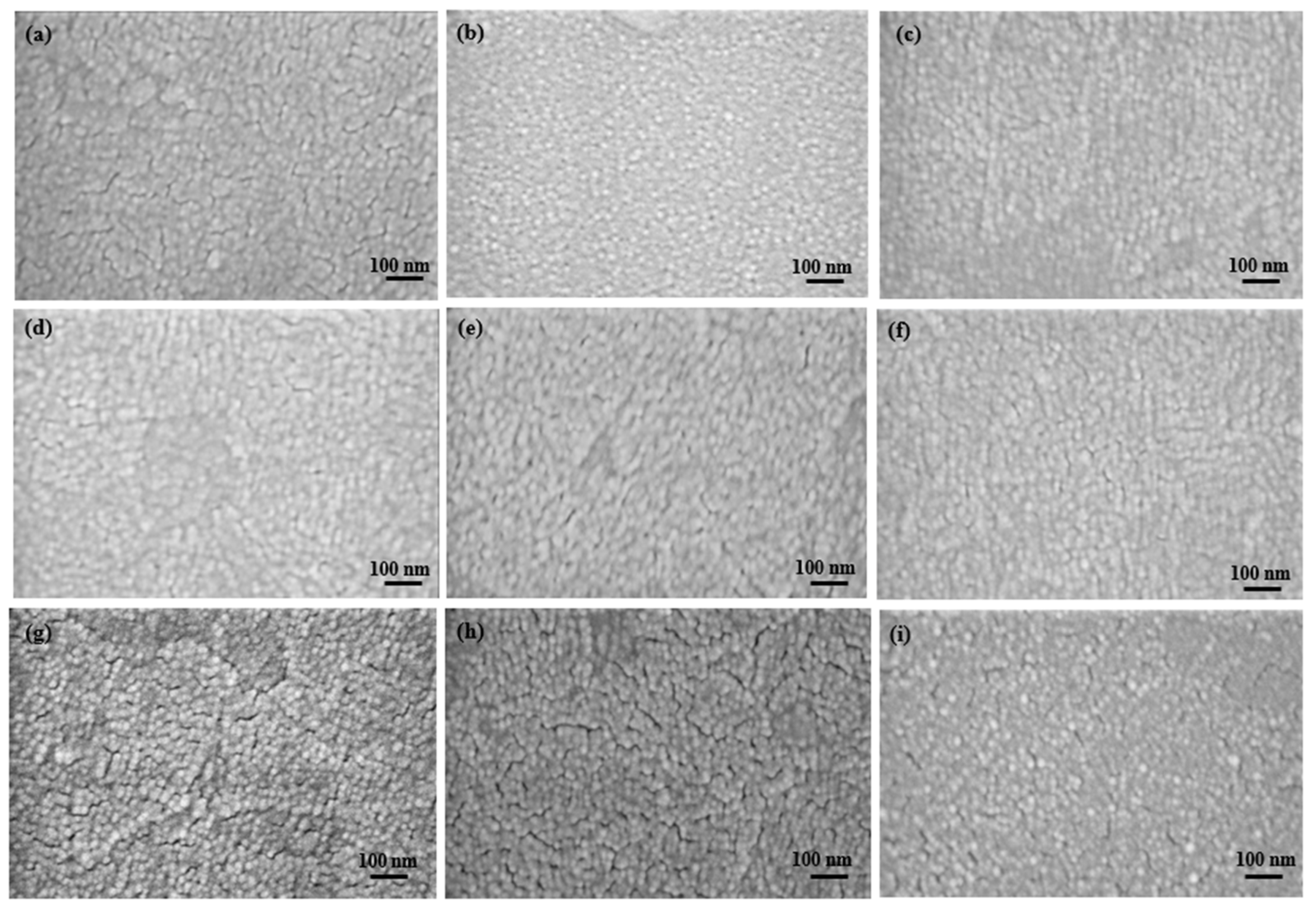
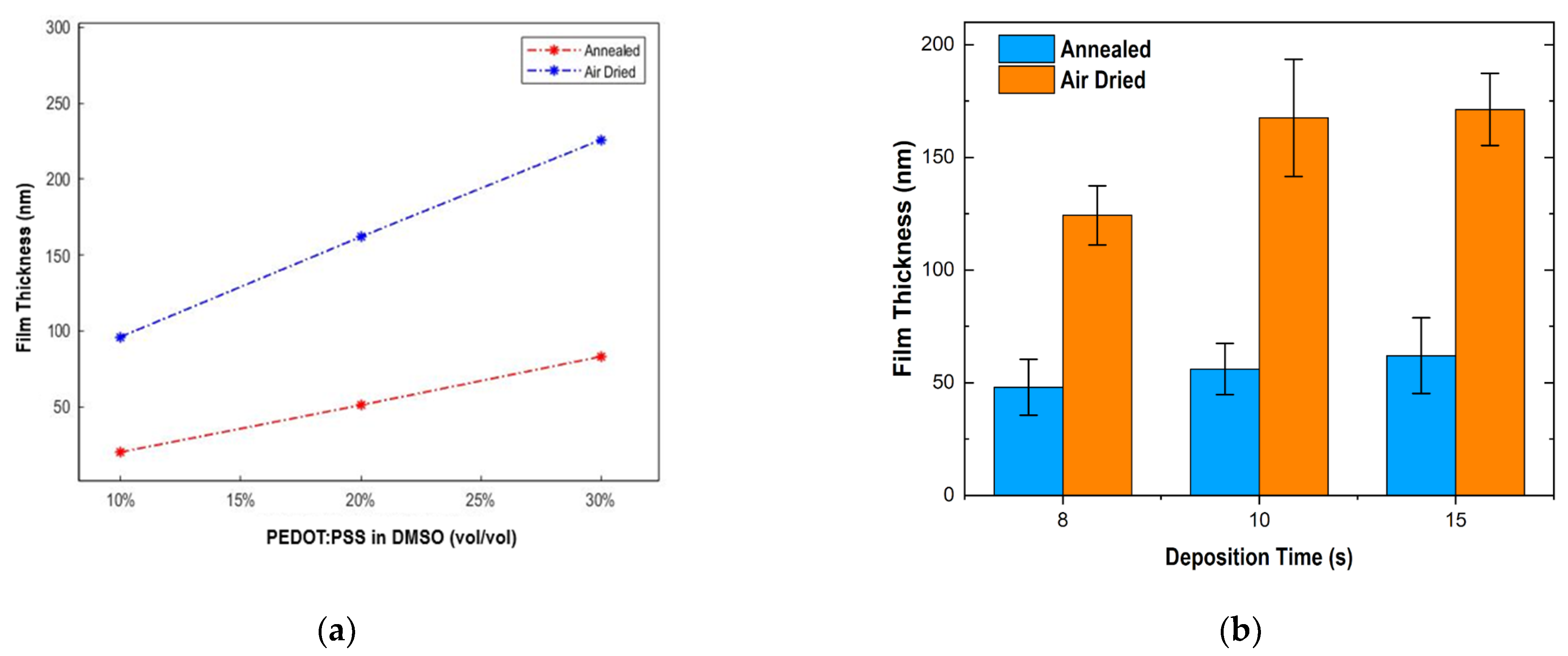


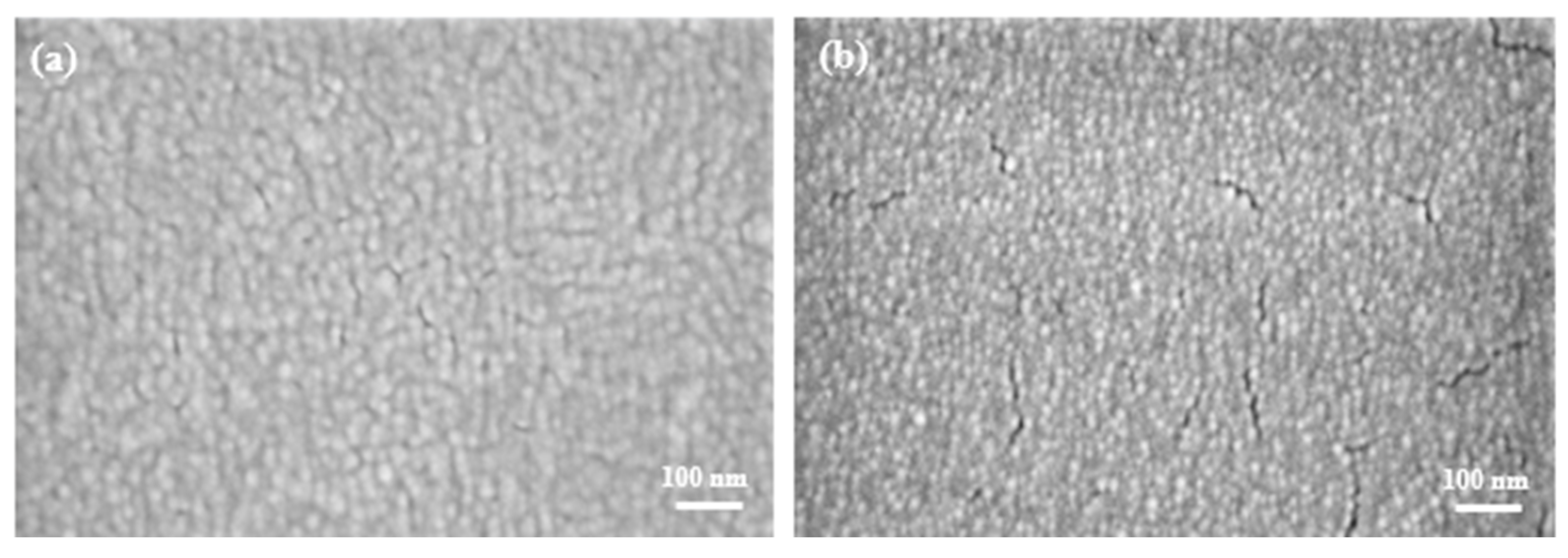
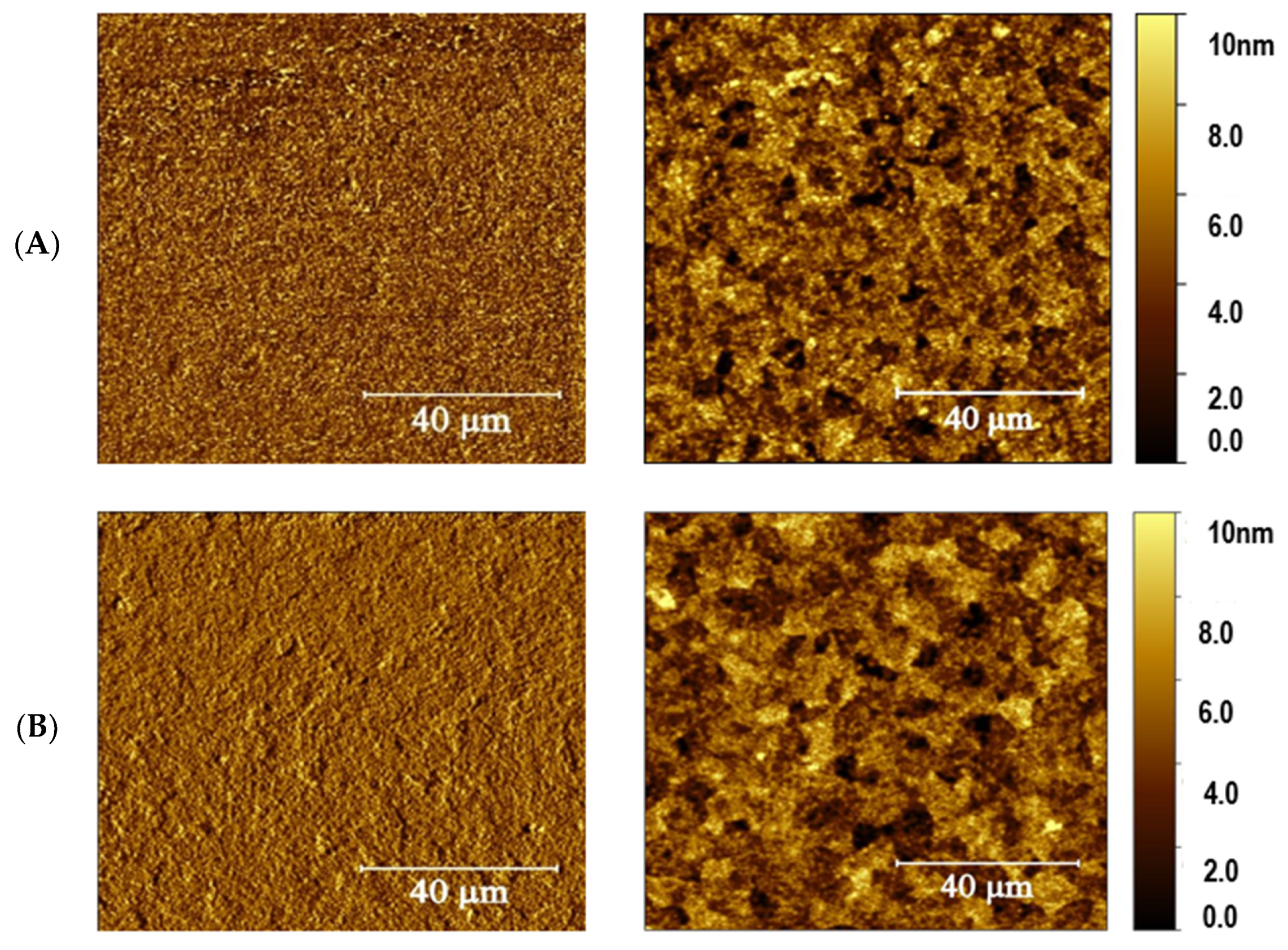
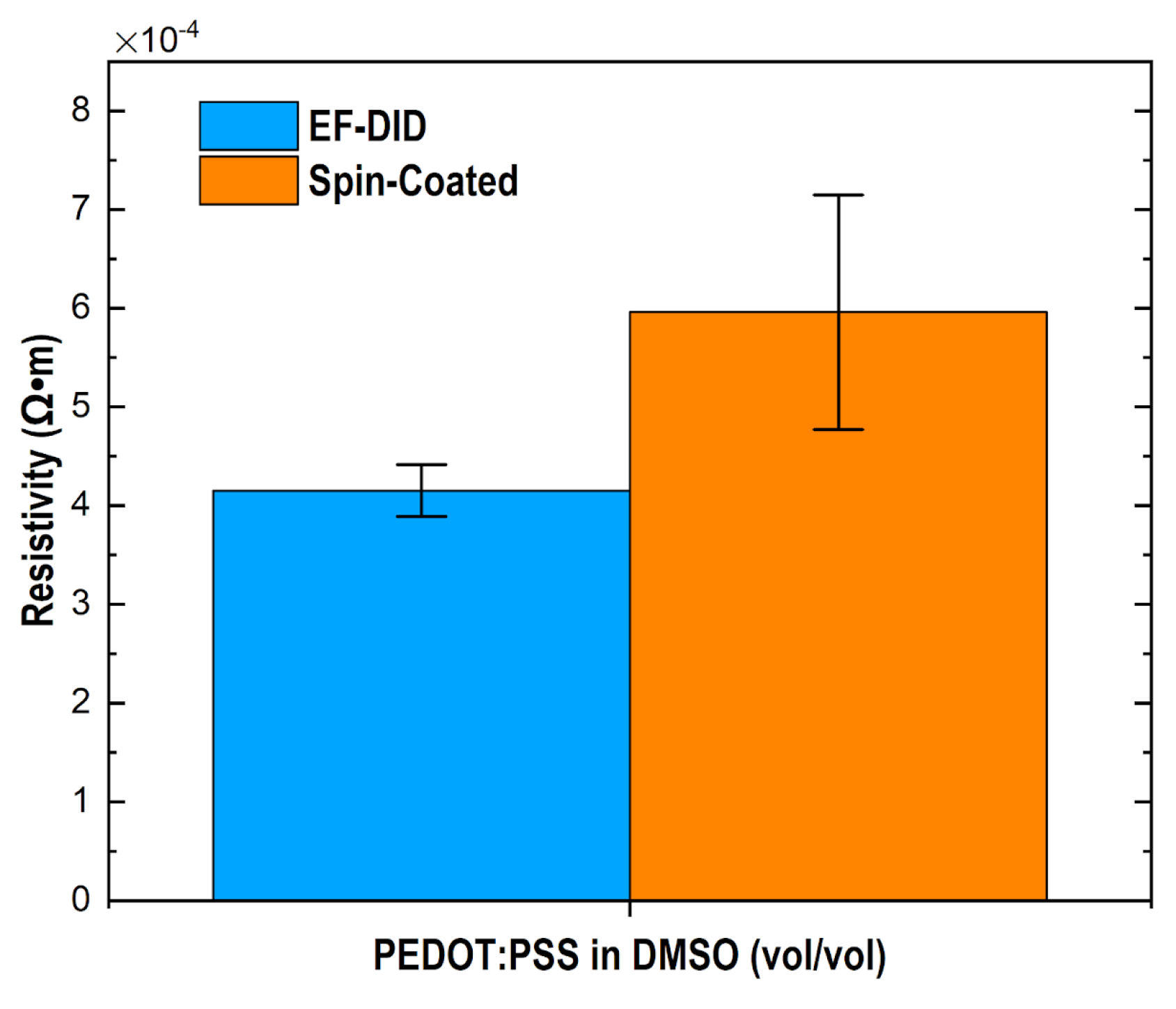
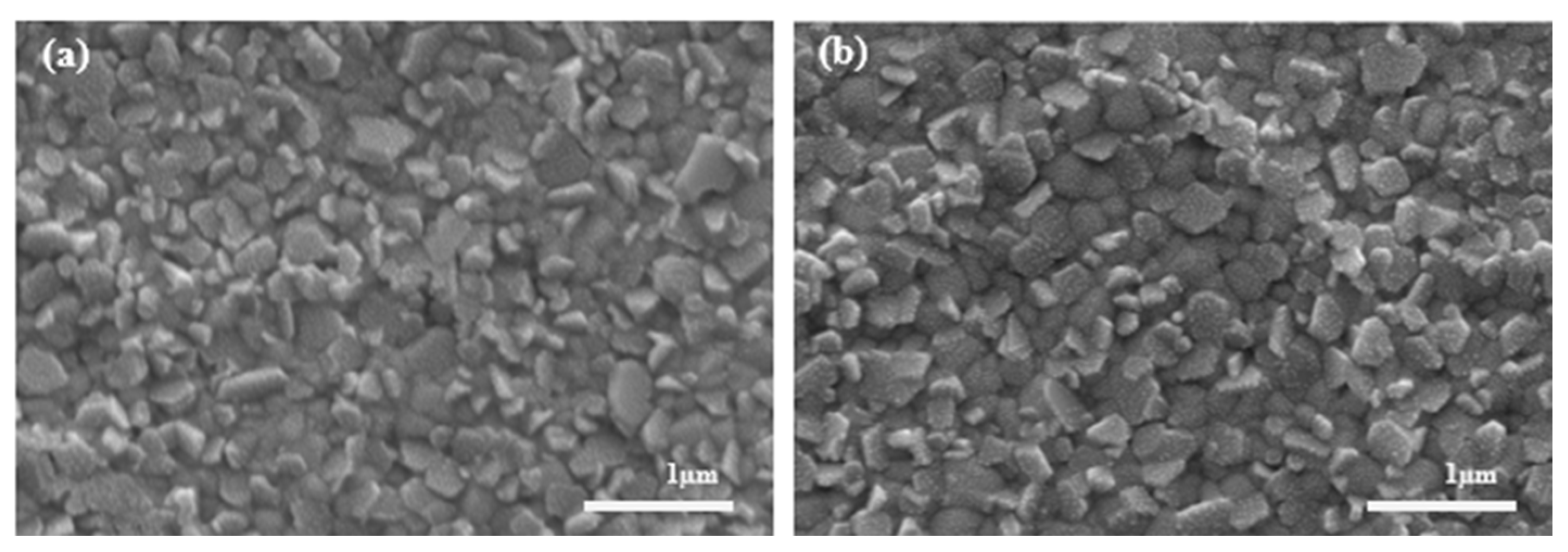
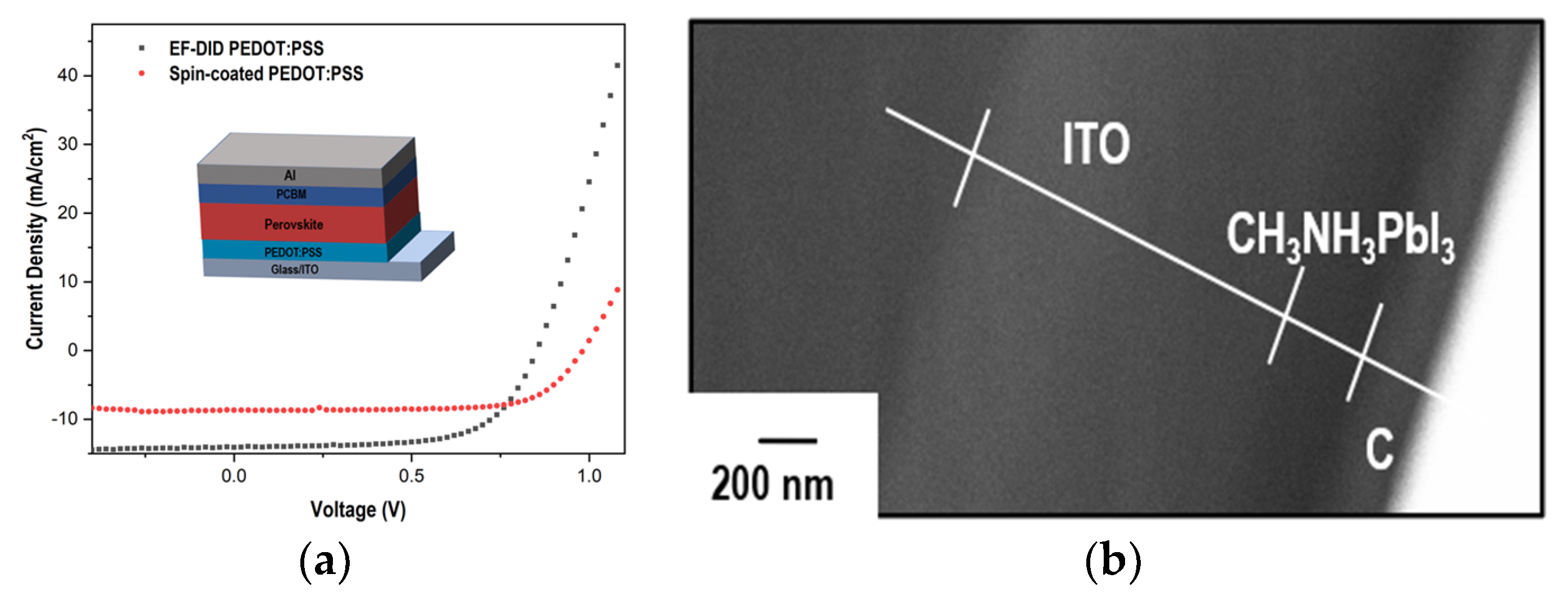
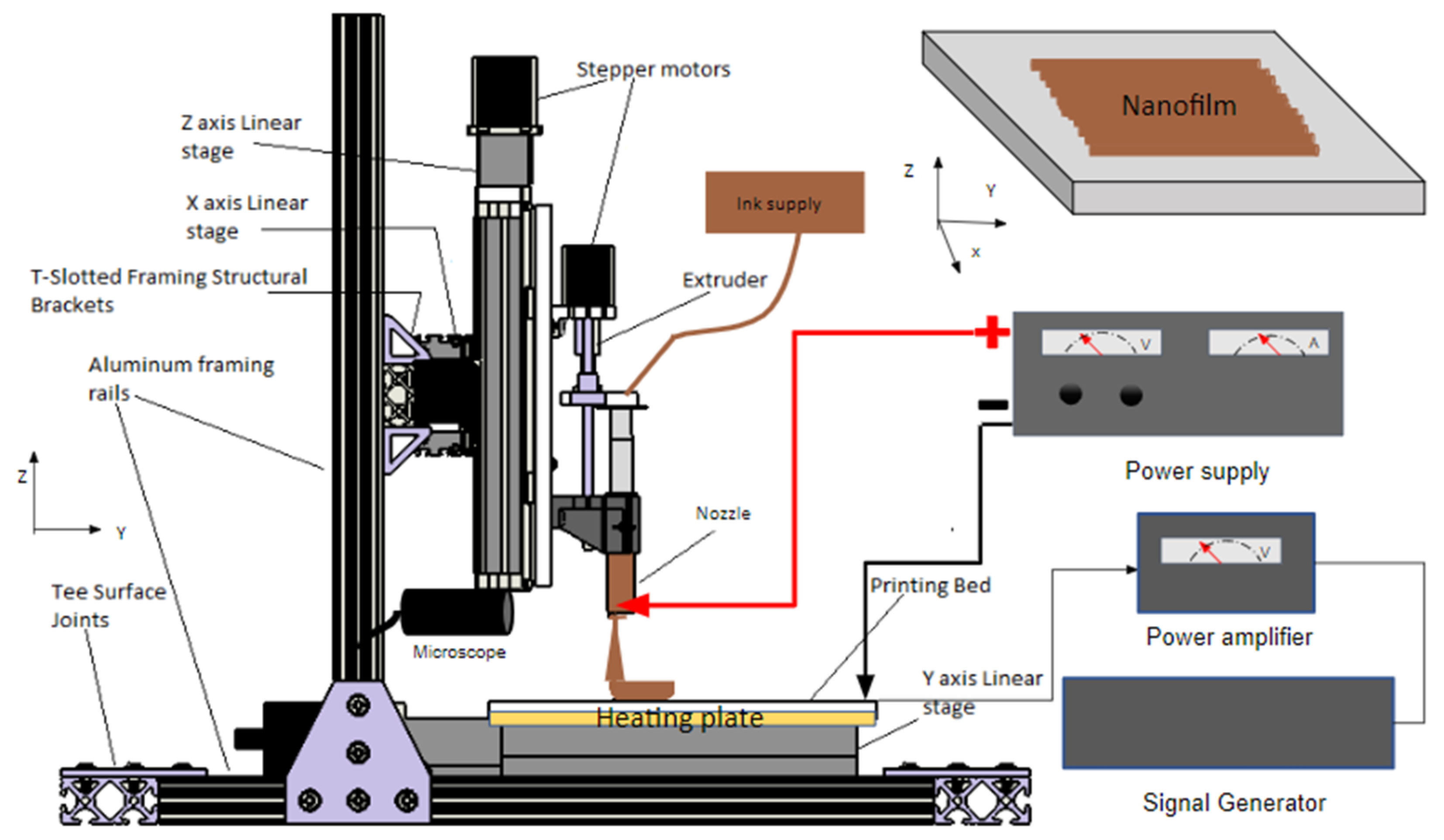

| Deposition Type | Efficiency (%) | Fill Factor | Voc (V) | Jsc (mA/cm2) | Rsh (Ωcm2) | Rs (Ωcm2) |
|---|---|---|---|---|---|---|
| Spin Coated PEDOT:PSS | 6.0 | 0.709 | 0.983 | 8.67 | 2857 | 15 |
| EF-DID PEDOT:PSS | 7.8 | 0.647 | 0.853 | 14.2 | 1003 | 5.5 |
Disclaimer/Publisher’s Note: The statements, opinions and data contained in all publications are solely those of the individual author(s) and contributor(s) and not of MDPI and/or the editor(s). MDPI and/or the editor(s) disclaim responsibility for any injury to people or property resulting from any ideas, methods, instructions or products referred to in the content. |
© 2023 by the authors. Licensee MDPI, Basel, Switzerland. This article is an open access article distributed under the terms and conditions of the Creative Commons Attribution (CC BY) license (https://creativecommons.org/licenses/by/4.0/).
Share and Cite
Gogoi, B.; Gockley, C.; Venu, S.; Zhu, Y.; Alluri, P.; Malik, A.A.; Despande, M.S.; Phadnis, R.; Amonoo, E.; Li, X.; et al. Ultrafast and Large-Scale Fabrication of PEDOT:PSS Nanofilms Using Electrical-Field-Assisted Direct Ink Deposition. Molecules 2023, 28, 5989. https://doi.org/10.3390/molecules28165989
Gogoi B, Gockley C, Venu S, Zhu Y, Alluri P, Malik AA, Despande MS, Phadnis R, Amonoo E, Li X, et al. Ultrafast and Large-Scale Fabrication of PEDOT:PSS Nanofilms Using Electrical-Field-Assisted Direct Ink Deposition. Molecules. 2023; 28(16):5989. https://doi.org/10.3390/molecules28165989
Chicago/Turabian StyleGogoi, Banashree, Carson Gockley, Sushmitha Venu, Yizhen Zhu, Pranith Alluri, Ayinawu Abdul Malik, Mitesh Suhas Despande, Raveena Phadnis, Evangeline Amonoo, Xiangjia Li, and et al. 2023. "Ultrafast and Large-Scale Fabrication of PEDOT:PSS Nanofilms Using Electrical-Field-Assisted Direct Ink Deposition" Molecules 28, no. 16: 5989. https://doi.org/10.3390/molecules28165989
APA StyleGogoi, B., Gockley, C., Venu, S., Zhu, Y., Alluri, P., Malik, A. A., Despande, M. S., Phadnis, R., Amonoo, E., Li, X., & Alford, T. L. (2023). Ultrafast and Large-Scale Fabrication of PEDOT:PSS Nanofilms Using Electrical-Field-Assisted Direct Ink Deposition. Molecules, 28(16), 5989. https://doi.org/10.3390/molecules28165989







